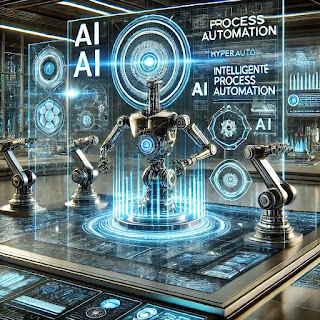What is Hyperautomation? A Guide to the Next Big AI Revolution ⚡
🚀 Introduction
The rapid rise of Artificial Intelligence (AI), Machine Learning (ML), and Robotic Process Automation (RPA) is driving businesses toward Hyperautomation—the next big revolution in AI-driven efficiency. But what exactly is hyperautomation, and why is it a game-changer for industries worldwide? Let’s dive in! 🤖
🤔 Understanding Hyperautomation
Hyperautomation is an advanced approach that combines AI, robotic process automation (RPA), and intelligent business process management to automate complex tasks at scale. Unlike traditional automation, which focuses on specific repetitive tasks, hyperautomation integrates multiple technologies to create an autonomous and intelligent digital ecosystem.
🛠️ Key Technologies Powering Hyperautomation
🤖 Artificial Intelligence (AI) – Enables smart decision-making and predictive analytics.
📊 Machine Learning (ML) – Helps systems learn from data and improve over time.
⚙️ Robotic Process Automation (RPA) – Automates repetitive, rule-based processes.
🗣️ Natural Language Processing (NLP) – Allows AI to understand human language.
📈 Business Process Management (BPM) – Enhances workflow automation.
🖥️ Low-Code/No-Code Platforms – Enables automation without extensive coding.
🌟 Benefits of Hyperautomation
🚀 Increased Productivity – AI-driven automation reduces manual workloads and improves efficiency.
💰 Cost Reduction – Businesses save on labor and operational costs.
✅ Higher Accuracy – Minimizes human errors and ensures consistent results.
📡 Scalability – Allows organizations to scale operations without additional workforce.
📊 Data-Driven Insights – AI extracts valuable insights to enhance decision-making.
🌍 Industries Embracing Hyperautomation
🏦 Finance – AI-powered fraud detection, automated reporting, and smart investment strategies.
🏥 Healthcare – AI-assisted diagnostics, patient data management, and robotic surgeries.
🏭 Manufacturing – Automated production lines, predictive maintenance, and supply chain optimization.
🛒 Retail – Smart inventory management, personalized customer experiences, and automated checkouts.
🎧 Customer Service – AI chatbots, sentiment analysis, and ticket automation.
🔮 The Future of Hyperautomation
The future of hyperautomation will bring even more advanced AI integrations, real-time decision-making, and self-learning algorithms. We can expect autonomous businesses, where AI-powered systems will handle entire workflows with minimal human intervention.
💬 What’s Your Take?
👉 Do you think hyperautomation will create more job opportunities or replace human workers? Let us know in the comments! 🤖💡

Comments
Post a Comment